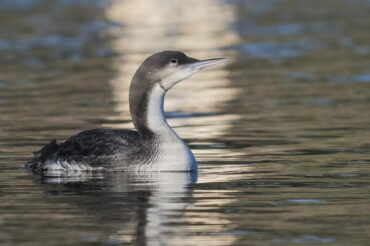Jim Hoagland
As Karen and John Vanderwall were headed to Ed’s Dogs for lunch on April 6, Karen noticed a different-looking bird species on the Ranch pond. The spring migration of waterfowl and other bird species was in full swing, but this was unlike any other bird she had observed on or around the pond. I was on my way back from Switzerland, so she knew I could not come down to help her identify it. She took several cell phone photos and emailed me her eBird checklist, having originally used a placeholder of Double-crested Cormorant with photos until it could be officially identified.
Having just returned from my trip, I visited the pond early the next morning. As I looked through my binoculars in the morning’s dim light, I was shocked. “Could it really be a loon I am looking at?” As the sun rose and the light intensified, I began to take several photos of the very cooperative loon. The eBird checklist for our area gave only the choice of a Common Loon. Needing groceries, I quickly posted a Common Loon and headed to town. Then around noon, I was contacted by the eBird reviewer Mark Stevenson indicating that Karen’s cell phone photos looked like a Pacific Loon and asked if I had any detailed photos. I quickly returned home to process the photos from the morning. Sure enough, it was a Pacific Loon, the first ever recorded in Pinal County.
For the next 10 days, the loon was observed by many SaddleBrooke Ranch (SBR) residents, and over 100 birders from all over Southern Arizona, many coming from 2 to 3 hours away to see our now–famous loon. I affectionately named it PALO, after the four-letter banding code which uses the first two letters of each word in its name, PAcific LOon. Every day after Karen’s discovery, I made an early morning trip to the pond to report to the birding community that the PALO was still here.
The Pacific Loon is probably the most abundant loon in North America. It is strictly marine, meaning along the Pacific Ocean, so to see it inland is a real rarity. Most sightings in Arizona of the Pacific Loon are in November and December during its fall migration south to Mexico on the west coast of Baja, California. It breeds in Alaska and Northwest Canada during a short three-month period on the Arctic and Subarctic tundra and taiga region of the continent.
I believe our visiting loon was in First Alternate Plumage, because the chin strap was very evident. The Second Alternate Plumage is one of the most beautiful plumages to see of a loon. We were also blessed to hear PALO calling several times.
The Pacific Loon was my 181st bird species to be seen here at the Ranch since moving here in June of 2020. Since then I have added six additional new species. When I reach 200 species, drinks are on me—well, maybe I won’t go that far!


